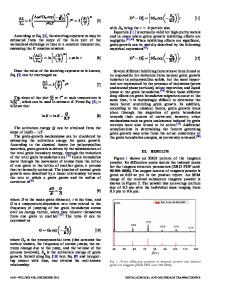Modeling of distortion after densification during liquid-phase sintering
- PDF / 248,582 Bytes
- 9 Pages / 612 x 792 pts (letter) Page_size
- 6 Downloads / 382 Views
I. INTRODUCTION
LIQUID-PHASE sintering (LPS) is commonly used to densify high-performance engineering materials.[1] The liquid acts to quickly densify the material by providing both a capillary force and a high diffusion pathway. However, the liquid also contributes to distortion in the component, resulting in poor dimensional control. Distortion is related to several factors, including green body heterogeneities. With respect to the unique aspects of LPS, the key parameters include the solid-to-liquid volume ratio, the microstructure and its evolution, and the external forces acting on the component. To model distortion, the microstructure effect can be addressed through an appropriate choice of viscosity model. In addition, the surface tension and density of the solid-liquid mass influence the extent and rate of its distortion. A critical observation in recent years has been the recognition that LPS systems largely distort after densification.[2,3] Accordingly, it is appropriate to treat the problem as a viscous flow process involving the semisolid mixture of solid grains in a liquid phase. In this article, a finite-element approach is used to solve continuity and momentum equations for predicting distortion during LPS for low dihedral angle materials and after full densification. Commercial software, FIDAP (Fluent Inc., Lebanon, NH) which solves equations for fluid dynamics with finite elements, was chosen for this task. Modeling of the distortion during LPS has been performed using Stokes’ equation by some authors.[4,5,6] Raman et al.[4,5] introduced the model using momentum and continuity equations that calculate the movement of fluid inside the sample. They used several assumptions to solve the equations. They first assumed that the cylindrical sample was made of a stack CHANTAL BINET, Material Process Researcher, KARA L. LENCOSKI, Undergraduate Student, DONALD F. HEANEY, Director of Process Development, and RANDALL M. GERMAN, Brush Chair Professor in Materials and Director, are with the Center for Innovative Sintered Products (CISP), The Pennsylvania State University, University Park, PA, 168026809. Contact e-mail: [email protected] Manuscript submitted September 25, 2003. METALLURGICAL AND MATERIALS TRANSACTIONS A
of thin disks that experience axial and radial velocity. It was considered that the top disk of the area to be calculated does not encounter any radial distortion. Material properties such as density were assumed to be constant during the process. A viscosity model based on suspension viscosity with a dependence on shear rate was chosen. The inertial terms of the momentum equation and curvature-driven surface traction forces were neglected. The simulations showed good agreement with experimental data after the viscosity was adjusted to follow the distortion. Ganesan et al.[6] used the same model without neglecting the inertial term in the equation. They also calculated the distortion in microgravity conditions by including surface tension effects. Here again, the distortion calculated agreed with t
Data Loading...











